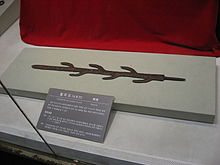Chiljido
| Seven-Branched Sword | |||||||

Replica of the Seven-Branched Sword, or Chiljido, at the War Memorial in Seoul, South Korea or Nanatsusaya no Tachi (shichishitō) in Japanese.
|
|||||||
| Japanese name | |||||||
|---|---|---|---|---|---|---|---|
| Kanji | 七支刀 or 七枝刀 | ||||||
|
|||||||
| Korean name | |||||||
| Hangul | 칠지도 | ||||||
| Hanja | 七支刀 | ||||||
|
|||||||
| Transcriptions | |
|---|---|
| Revised Hepburn | shichishitō or nanatsusaya no tachi |
| Transcriptions | |
|---|---|
| Revised Romanization | chiljido |
| McCune–Reischauer | ch'iljido |
The Seven-Branched Sword (Japanese: 七支刀 Hepburn: Shichishitō?) is a sword of continental manufacture believed to be identical with the artifact of that name, a gift of the king of Baekje that has been bestowed upon a Yamato ruler as a gift who is mentioned in the Nihon Shoki in the fifty-second year of the reign of the semi-mythical Empress Jingū. It is a 74.9 cm (29.5 in) long iron sword with six branch-like protrusions along the central blade. The original sword has been conserved since antiquity in the Isonokami Shrine in Nara Prefecture, Japan and is not on public display. An inscription on the side of the blade is an important source for understanding the relationships between kingdoms of the Korean peninsula and Japan in that period.
The blade of the sword is 65.5 cm and the tang is 9.4 cm long. There is no hole on the tang to fasten the sword with a hilt. The sword is broken at the top of the tang. Analysis of the broken surface shows the material of the sword is forged mild steel. As the ‘branches’ appear to be quite delicate, and their functionality in melee combat doubtful, it is unlikely that the Seven-Branched Sword was used as a military weapon. Instead, it probably had a ceremonial function.
The sword has been stored in the Isonokami Shrine since ancient times. The inscription on the blade had been hidden by rust and was rediscovered in the 1870s by Masatomo Kan, a Shinto priest at the shrine. There is a two-sided inscription on the sword which is inlaid in gold. This sword appears to have been mentioned in the Nihon Shoki. Many scholars have engaged in study to interpret the vague inscription. Closeup pictures of the sword taken with X-ray were published in 1996.
...
Wikipedia
